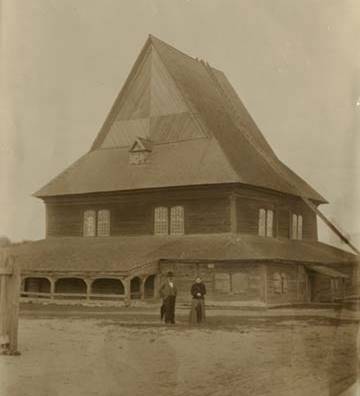

|
Dubrowna, Belarus
Alternative Names:
Dubrovno [Rus, Yid]; Dubroŭna
Belarusian: Дуброўна
Polish: Dąbrowna
Russian: Дубровно
Yiddish: דובראװנע
DESCRIPTION:
Dubrowna is
located along both banks of the Dnieper River.
Its name is a toponym for an "oak forest", and the town’s coat of arms
includes an oak tree. It is the administrative
center for the Dubrowna raison of the Vitebsk
oblast. Dubrowna is eleven miles east of Orsha, on the highway to Smolensk, located in Vitebsk
Region.
Location:
54° 34' N. lat.; 30° 41' 9" E. long.
MAPS:

HISTORY
The town is mentioned from the early
1500s, and Jewish settlement in Dubrowna dates to the
mid-16th century, when the region was a part of Lithuania. Due to wars between the Russians and the
Lithuanians, the town was burned several times in the late 1500s.
In 1738, a Jew from Dubrowna,
Baruch Leibov, was burned at the stake in St.
Petersburg for proselytizing.
A center of Lubovich
Chassidism, as early as 1792 copies of the Tanya (essays and discourses forming
a guide for religious devotion, and practical and religious ethics, written by
Rabbi Schneur Zalman, the
Alter Rebbe) were being produced in Dubrowna by qualified scribes.
Dubrowna was also a center for woven woolen tallesim which were sold throughout the Russian empire. Jews also worked as artisans and day
laborers. In 1801 a Jewish printing
house was established. As of 1906, Jewish charitable institutions included a society for
the aid of the poor, founded by the governor of the province, a bikkur holim (visiting the sick) and
a lehem ebyonim (food for
the needy). Children were taught in the Talmud Torah (72 pupils). There were twenty-six hadarim
(Jewish elementary schools) serving 210 pupils, a yeshivah with sixty pupils, a secular
government school attended by 175 pupils, some of whom also attended the
yeshivah or the hadarim, and a district school, with
thirty-six pupils in the industrial departments.
In modern times, a folk song and dance festival “Dnepr Voices in Dubrowna” is held annually.

|

|
POPULATION
1897: 7,974 of whom 4,364 were Jews.
1939: 10,100 of whom 2,119 were Jews.
RELIGIOUS LIFE
There were seventeen prayer houses and one
synagogue (pictured below in 1905).

Under the local Soviet body, the synagogue
was converted into a Communist club in 1929.
Thanks to a decree by Joseph Stalin that no place of worship should be
converted for other use unless a majority of those concerned and the Soviet
Central Executive Committee sanctioned it, in 1930 the Jews of Dubrowna took the unprecedented step of requesting that the
synagogue be returned to them. When the
chairman of the local Soviet refused, the Jews went to the synagogue, removed
the lock and replaced it with their own.
When members of the Communist club arrived, they found the entrance
barred. The Jews felt justified in this
action and planned to reopen the synagogue for Passover services.
LIFE IN DUBROWNA
Interview with Nina S.
Interview with Zinaida Z.
FAMILIES
CEMETERY PHOTOS AND INSCRIPTIONS
The Dubrowna
Jewish cemetery used to be several times larger than it is currently. Most of the cemetery’s former territory is
currently a soccer field. The cemetery
is fenced with a blue chain. There is a
college nearby, and the students take care of the cemetery, cutting the grass
once a year and re-painting the chains every three years.
FAMOUS JEWS FROM DUBROWNA
FRUMKIN,
Israel Dov (1850-1914), journalist
BATSHAW, Harry (1902-1984), jurist
JAFFEE, Charles (1879-1941), chess master
POLYAKOV, Lazar, Yakov, & Samuel; brothers & businessmen
POLYAKOV, Samuel, Yakov, & Lazar; brothers & businessmen
USSISHKIN, Menachem (1863-1941), Zionist
ZEITLIN, Zvi (1922-2012), violinist
WICHEFSKY, David (1857-1922), Rabbi
Sources
1906 Jewish Encyclopedia; article by
Herman Rosenthal, S. Janovsky
Yuri Dorn
Jewish Heritage Research Group
Wikipedia
Diana R.
Nina S.
Zinaida Z.
Dubrovna Jews Demand Return of Their Synagogue
Jewish Virtual Library: Saint Petersburg
Chanukah: Publication of the Tanya
Created by JP January 2019
Last updated by JP February 2021
copyright © January 2019 Judy Petersen
Email: Judy Petersen
This site is hosted at no cost by JewishGen,
Inc., the Home of Jewish Genealogy.
If you have been aided in your
research by this site and wish to further our
mission of preserving our
history for future generations, your
JewishGen-erosity
is greatly appreciated.